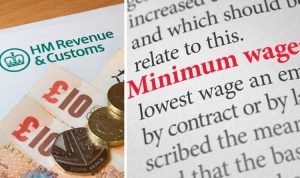What are dividends? In short, dividends are company profits which are paid out to the people who own the company’s shares.
Some companies pay quarterly or even monthly dividends, such as BP and Shell. Others have famously never paid a dividend, like Berkshire Hathaway, focusing instead on re-investing profits.
A company doesn’t have to pay dividends to shareholders but, if this is your own company we’re talking about, I’m guessing you are planning to enjoy the fruits of your labour.
What AREN’T dividends?
This is a really important point. Aside from dividends, there are (generally) two other ways of getting cash out of your company. They have very different processes and, crucially, different tax implications. Mixing these up could be the most expensive mistake you make this year.
Firstly, you can be paid a salary for the work you do in your company. Just as with any other employment, you get a salary each month which will have tax, national insurance and pension contributions deducted. The figures (and taxes) are submitted to HMRC, and you’ll get a payslip showing the gross/net figures etc.
Or, you can take a loan from the company. There’s no tax deducted up front but, you guessed it, one day you’ll need to repay the loan – and in the meantime, the company will be charging you interest. There’s also a hefty tax charge on companies who make loans to shareholders.
In a “normal” company, the owners and the staff are usually very much separate people. But in your own Limited Company, you’re the owner AND the staff. So the line between paying salary and paying dividends can become blurred.
Clients don’t normally care whether they receive dividends or salary, or a mix of the both. They just ask me “what’s the most tax-efficient way”.
Advantages of dividends over salary
Famously, dividends (generally) attract a much lower rate of tax than salary – if you’re a basic rate taxpayer, you’ll pay about 9% on your dividends, and 28% on your salary. For a higher rate taxpayer, that’ll be 34% and 42% respectively.
As an employer, the company will pay 14% National Insurance on your salary (that’s in addition to your own NI!), whereas no NI is payable by the company, or by you, on dividends.
There’s also no tax deducted at source from dividends. So as well as paying a lower rate overall, you also get a massive grace period: A salary paid in April 2025 will be taxed in the same month, but a dividend from that same month won’t be taxed until January 2027!
Disadvantages of dividends over salary
They certainly have their place as part of your remuneration strategy (if you’re asking “what’s that”…stop reading this and give your accountant a call), but dividends aren’t all sunlight and roses.
Although you pay a lower rate of tax on dividend income, the company doesn’t get any tax relief on the payments. Whilst salary payments are a normal business expense, and hence reduce taxable profits, dividends are a return of profits to shareholders, so no tax relief is due.
Following on from that, you can only pay dividends if the company has the reserves to pay them (i.e. it is not insolvent), whereas a salary can be paid at any time. “Reserves” are not the same as “cash”. Post-Covid we are commonly seeing companies which have cash in the bank but it’s a result of a bounce-back loan, and isn’t cash generated from profits.
Speak to your accountant before declaring a dividend if you think this might affect you – it’s illegal for a company to pay a dividend if it doesn’t have the reserves to do it.
Where there’s more than one shareholder involved, you need to split the dividend according to share ownership, regardless of what might be more tax efficient. So for example, if you and your partner are 50/50 shareholders, you must both receive 50% of the dividend. If you already earn a pretty penny from another job but your spouse has no other income, that’s a bummer – you’ll pay 34% on your dividend, whilst your spouse pays just 9%.
Although this is fair from an asset protection point of view – imagine if Amazon could just pick and choose how much to pay to each shareholder! – it isn’t always a great outcome for small family-owned businesses.
There is however a solid workaround for this, which involves creating different share classes with different rights attached to them. If you think this could benefit your company, speak to your accountant ASAP.
What about record keeping?
This bit is important! British Gas can’t just give some money to its shareholders with no paper trail, and neither can you. Without supporting documentation, HMRC are entitled to assume the payment was a loan, and will tax it accordingly. Or make you repay it. And that’s not good!
You also need to make sure you’ve got the reserves to pay it, and people very often overlook CORPORATION TAX here. Let’s say you’ve made £50K profit so far this year. You’ve got £50K in the bank so you can declare a £50K dividend, right?
Wrong.
You need to work out your post-tax profit, and take corporation tax into account, even though it won’t be paid until after the company’s year-end.
In our example, assuming tax is 20%, this means you’ve got POST TAX profits of £40K (£50K – 20%), and that’s the maximum dividend you can declare right now. Your accountant can prepare some reserve figures for you although if your record-keeping is meticulous (and/or you’re only looking to declare a small dividend) then you may be comfortable doing this yourself.
(Note here that we’re talking about cumulative profits – e.g. if you made £40K after tax for two years in a row, but took no dividends in year 1, you can take £80K in year 2, that’s fine).
As a director, you’ll need to make a written statement not only about the amount/date of the dividend to be declared but also that you’ve satisfied yourself that the dividend can be supported by retained earnings, if you’re called to rely on it
I’ve prepared a template which you’re free to download and amend to suit – each time you pay a dividend from the company, save a copy of the declaration (it doesn’t need to be on paper – digital is fine).
Illegal dividends
This is something we see too often.
During the year the director has drawn every last penny from the company as a dividend, and come the end of the year, after taking into account a provision for corporation tax, the company is now insolvent.
First off, your accounts will be filed at Companies House for the public record, so everyone (and specifically your bank, your customers and your suppliers) will see that your company has more liabilities than assets. This will trigger alarm bells, especially if you have a loan/overdraft with the bank, or if you have suppliers who you pay on credit terms.
That in itself could spell disaster for the business.
Secondly, if the company were unable or unwilling to pay its debts, then creditors (especially HMRC!) could petition for those illegal dividends to be reversed, and the shareholders would find themselves in a rather awkward position of having to REPAY the dividends back to the company. Ouch!
Getting this right
As ever, the cost of professional advice in getting this right will always be far less than the cost of getting this wrong, especially if there’s big numbers involved. If you can engage an accountant BEFORE setting up a company that’s even better, as it’s more complex (and therefore expensive) to start restructuring a trading company than it is to set it up right from day one.
Our Tax-Fit report might just be what you need – as part of this, we’ll have a meeting with you to uncover your personal and business financial positions and projections, then we go away and run all sorts of scenarios behind the scenes to tell you in clear terms what the most tax-efficient path for your business will be. The cost is a simple £480 plus VAT.
If you’d like to treat yourself to peace of mind and tax savings, contact peter@blue-penguin.co.uk or call 01823 297000.


